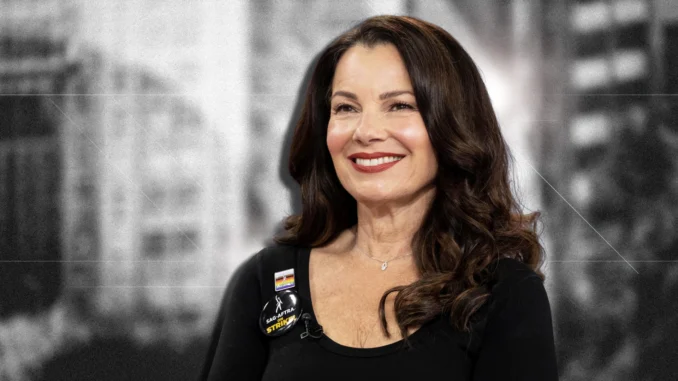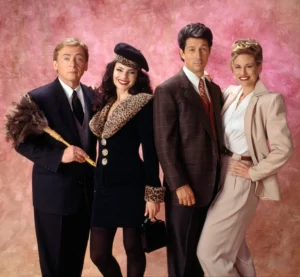
From writers to auto workers, 2023 will be known as a pivotal year for labor, and no figure has been more prominent than Drescher.
I hear Fran Drescher before I see her.
I’m waiting for her in a conference room in the Los Angeles headquarters of the Screen Actors Guild—American Federation of Television and Radio Artists (SAG-AFTRA) on a hot day in late August. It’s been 41 days since SAG-AFTRA announced that, after contract negotiations broke down with the Alliance of Motion Picture and Television Producers, its 160,000 members were going on strike. In the intervening weeks, Drescher, who has been president of the union since September 2021, has been attending picket lines and crossing the country for speaking events and interviews. Today, she’ll do even more.
Over my shoulder, there’s a wall of photos depicting the union’s history and notable members, including Rita Hayworth, Gene Kelly, and Ronald Reagan, who famously served as president of the guild for seven terms, launching his path to president of the United States. Suddenly, Drescher’s unmistakable voice echoes through the headquarter’s lobby from the floor below. I can’t make out her words, but I know she’s on her way.
Even in the face of her famous predecessor, Drescher may be the most compelling—and undeniably the most meme-able—labor leader in recent history. Best known for portraying the working-class “flashy girl from Flushing” on The Nanny, Drescher has led her union with characteristic chutzpah and established unexpected unity. In July, 98% of SAG-AFTRA members voted in favor of the union’s historic strike and most U.S. voters support the strike as well. With actors’ residual payments in sharp decline, and the specter of unregulated generative AI looming, the guild is demanding a contract that finally accounts for an industry transformed by the digital age.

“I’ve always had this innate need to go to the mat for any group that’s being marginalized or diminished. I leverage my celebrity for the greater good,” she tells me once she’s settled into the room, wearing a decidedly practical black suit. “I’m grateful for my global celebrity so that I can speak on a variety of platforms that I might not otherwise be able to speak to, with the kind of visibility that I’m able to get.”
Drescher’s partner throughout the strike is SAG-AFTRA’s national executive director and chief negotiator, Duncan Crabtree-Ireland. He says he watched Drescher on The Nanny when he was growing up. “Didn’t everybody?” he asks. “Even my 18-year-old daughter is a fan of Fran from The Nanny, because of its second life of streaming.”
That show turned Drescher into a cultural icon. When The Nanny hit television screens in 1993, it introduced the world to a Drescher-inspired working-class woman with a penchant for Dolce and Gabbana and a heart of gold. Three decades later, that image—a blend of glamour, authenticity, and conviction—still reverberates. TikTok is filled with style inspo videos of The Nanny-era Drescher, RuPaul’s Drag Race contestants have conjured her looks, and a pair of Brooklyn comedians host a weekly LGBTQ-focused open mic night named “Fran,” in honor of her unapologetic confidence. “She’s a well-dressed hero of the working class,” says cohost and comedian Mariposa Coalson.
What many may not realize is that Drescher was also the co-creator, executive producer, and writer of The Nanny. Indeed, throughout much of her career, she’s been both a performer and a producer, connecting with audiences while simultaneously wielding influence behind the scenes, a duality that’s culminated in her leadership throughout the strike.
Drescher and her team are finally returning to the bargaining table on October 2—the first time the actors and studios will have met since the strike. Expectations for what SAG-AFTRA will come away with are high. The Writers Guild of America (WGA), which went on strike in May, just reached an agreement with a coalition of Hollywood’s biggest studios, streaming services, and production companies. The deal, which ends the WGA’s nearly 150-day-long walk out, notched significant wins for union members: compensation increases and minimum staffing requirements for writers rooms, better residual payments for streaming (and unprecedented transparency into streaming data), and protections against artificial intelligence being used to replace writers or being trained on their work.
The WGA contract, in other words, has set the stage. It’s call time for Drescher and her team.
“My neighborhood was a big union neighborhood,” Drescher says of Flushing, New York, where she grew up in the 1960s. Her father was a naval systems analyst and mother was a bridal consultant. Drescher says many of her neighbors were members of the local electricians union. “I come from a very grounded, earthy, provincial family with very—I think—good values.
